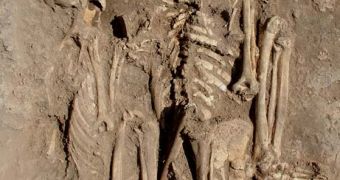The skeletons of a "Romeo and Juliet" couple found last February near Verona, Italy, could be pretty young compared to their newly found Turkish counterparts, 3,000 years older.
The two ancient skeletons encountered in each other's arms in a grave in Turkey seem to be the subject of the oldest love story to last for eternity. The bones could belong to a 30-year-old man and a 20-year-old woman, and were discovered last week in the southeastern Turkey (province of Diyarbakir, Bismil district) under the floor of an ancient house at the Hakemi Use site.
"The researchers dated the skeletons to 6100 B.C.," said lead researcher Halil Tekin, an archaeologist at Hacettepe University in Ankara.
The individuals could have belonged to the ancient Hassuna culture which flourished in northern Iraq.
"The way they were buried signifies that they were lovers. An illness or even a crime of love may have been the cause of their deaths. We will learn much more about them after anthropologists in our university complete their examinations on the skeletons." Tekin told Anatolia news agency.
The Hakemi Use site will be swallowed by waters when the Ilisu Dam on the Tigris River is finished and Tekin has been carrying out salvage digs since 2001. By now, digging has revealed Hassunan pottery items, showing that this culture spread from northern Mesopotamia to Turkey.
"Hakemi Use now seems to form the northernmost border of Hassuna/Samarra [pottery] ware in the Near East," wrote Tekin. If the couple died 8,000 ago, the period of time when they were alive coincides with the period when Hassunan prevailed in the area. Of course, not everybody agrees with the romantic version of the skeletons.
"The single photograph illustrated does not actually even indicate that they are embracing. They are both in a flexed position lying on their side, but the word 'embracing' is not indicated by the evidence." said C. C. Lamberg-Karlovsky of Harvard University's Peabody Museum of Archaeology and Ethnology.
"Maybe they are just two people who died on the same day and were buried together. Maybe it's a brother and sister who died in a plague. Maybe it was two men. Until they conduct DNA tests and determine the genetic similarities between them, there is no way of knowing much of anything about this." said Yossi Garfinkel, of the Hebrew University of Jerusalem's Institute of Archaeology.

 14 DAY TRIAL //
14 DAY TRIAL //